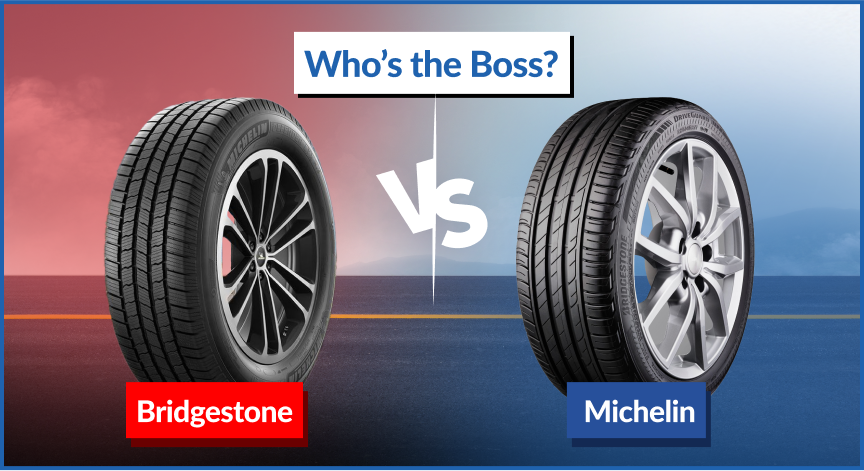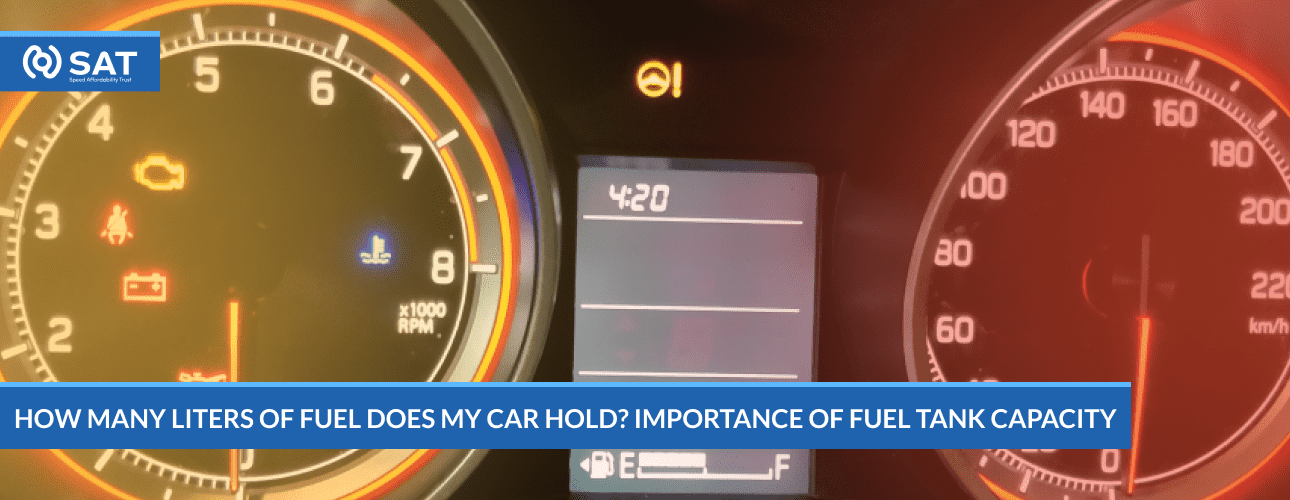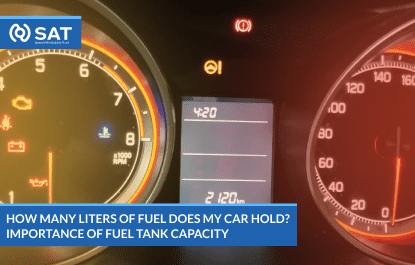
Bridgestone Vs. Michelin Tires – Who’s the Boss
Bridgestone and Michelin are the two industry giants of the tire market.

Considering the recent developments in the world order, oil prices have increased significantly over the last decade. During such times, being well-researched about your car fuel tank and its features can be extremely useful in cost-cutting. Knowing about your car’s fuel capacity may not seem too significant at face value, but such a basic factor can also be helpful with preparation.
The fuel tank is one of the most integral parts of your car’s engine system. It stores flammable fuels such as oil and gasoline, which power the engine and propel your vehicle forward.
Many people ask, how many gallons of gas does a car hold? The average fuel tank capacity of cars is determined by their size. A smaller car will possess a fuel tank capacity of around 12 litres while a larger vehicle will possess a fuel tank capacity of around 15 or more gallons. The only way to determine the exact number of gallons your tank holds is by finding out yourself. A more important piece of information you must determine is the MPG i.e. the miles per gallon your vehicle can travel. This variable is the number of miles your car can operate, on a gallon of fuel. For example, if your car’s fuel capacity is 20 gallons, and if each gallon serves 5 miles, then multiplying the two, you’ll determine that your car can drive 100 miles for its entire tank capacity.
The main function of the fuel tank is to store fuel and supply it throughout the vehicle. The fuel tank holds gasoline or petrol for the vehicle, and without a well-functioning fuel tank, the entire vehicle is prone to dysfunction. Furthermore, during the distribution of fuel, the tank has additional parts such as the Fuel Pump, fuel gauge, and fuel lines, which transmit and deliver fuel from the tank to the engine.
The fuel tank ensures that the fuel is stored safely and delivered to the engine in the right quantity and at the right pressure. It is equipped with various components such as the fuel pump, fuel lines, and fuel gauge, which work together to ensure that the fuel is supplied to the engine efficiently. Additionally, to ensure that there’s no pressure build-up or wrongful combustion, modern fuel tanks have ventilation systems that ensure the vehicle operates safely.
The fuel tank is an essential component of a vehicle, which cannot undergo combustion or depreciation. This car part is made with non-corrosive and durable materials such as aluminum, steel, and high-density polyethylene. The shape of the fuel tank is engineered to fit into the shape of the car and maintains the balance and performance accordingly.
The size of your vehicle determines the average gas tank size. For example, a small car normally holds about 12 gallons of gas. A larger car with a bigger tank can hold about 15 gallons of gas and even more in a few cases.
You may have heard the term “reserve tank” thrown around in movies or by adults when you were a child. The term “reserve tank” refers to vehicles with extra tank capacity. Reserve tanks contain about 15% of the capacity of the primary tank. However, new models do not come with reserve tanks, and you can find these tanks only in vintage models built for long-distance travel.
A majority of modern cars stop functioning when there are only 5 to 10 liters of gas left in the tank, making it impossible for you to empty your tank fully. Also, the new cars with reserve tanks indicate the quantity after including the reserve tank. Moreover, for obvious reasons, the fuel light will inform you about getting low on gas before you hit that 5 to 10-liter mark. Such smart preventative measures are an efficient way to ensure fuel reservation at all times.
Toyota Corolla has produced several cars over the decades, and they are available in different fuel types, including petrol and diesel, with automatic and manual transmissions. Models from 2002 and above offer 55L fuel capacity, while most models before 2002 offer 50L fuel capacity.
The answer to this question is both yes and no. The explanation for this bizarre answer is that some manufacturers intentionally keep the tank size bigger to prevent vapor locking (when liquid fuel changes to vapor in the tank). The gas chamber is bigger, not for extra fuel but to provide room for air.
The fuel price varies by period and location. In general, to calculate the cost of your tank, multiply the price per gallon by the size of your tank. For example, if a gallon costs about $5 and your tank holds a capacity of 20 gallons, then a full tank would cost you about $100. However, a point to consider is that fuel efficiency varies in every vehicle, so the miles you will travel in a full tank will differ from one vehicle to the other.
The Ford Super Duty is an innovative pick-up with the biggest fuel tank capacity. This car holds around 34 gallons or 181 liters of fuel; it hauls heavy cargo and a large number of passengers, made for divers who want to save the time and money spent at gas stations during long-distance trips. It is a no-brainer that a vehicle with the highest fuel tank capacity will be a fuel-efficient and practical choice. However, your fuel uptake can only be determined by the MPG value of the vehicle.
Not only will your vehicle stop all of a sudden, but driving it at really low fuel can also cause damage to your car. As the level of fuel keeps getting lower, your car can pick up debris from the bottom of the tank, which can cause damage to the fuel filter and pump. Moreover, it can cause damage to your catalytic converter. In the end, leaving your vehicle completely dry can cause costly damage to your car.
The majority of the vehicles have an engine management system that shuts down before your engine can get into any sort of trouble. However, there is no such system in place if you drive a petrol vehicle.
Here are a few tips and tricks that can help you make your vehicle’s fuel go the extra mile:
If you’re in the predicament of running out of fuel before reaching the gas station, the most suitable option is to pull your vehicle and turn the hazard light on. You should immediately contact someone who can bring fuel for you and not drive hoping you’ll reach your destination. This way you avoid being vulnerable, and stranded on a road.
In conclusion, understanding the fuel tank capacity and its functionalities is crucial for efficient vehicle operation and cost management. From the integral role of the fuel tank in storing and delivering fuel to the significance of MPG (miles per gallon) in determining your vehicle’s fuel efficiency, every detail matters. Modern advancements, such as smart preventative measures in fuel tanks, further ensure the safety and efficiency of vehicles. Whether it’s a compact car with a 12-gallon tank or a Ford Super Duty with a massive 34-gallon capacity, knowing these specifics can help you make informed decisions and maintain your vehicle better.
For those looking to explore the world of used cars, SAT Japan stands out as the leading and largest marketplace for used cars for sale. With an extensive range of options and a commitment to quality, SAT Japan ensures you find the perfect vehicle to suit your needs.

Bridgestone and Michelin are the two industry giants of the tire market.

Considering the recent developments in the world order, oil prices have increased significantly over the last decade. During such times, being well-researched about your car fuel tank and its features can be extremely useful in cost-cutting. Knowing about your car’s fuel capacity may not seem too significant at face value, but such a basic factor […]

Subaru is widely known for being a highly reliable manufacturer of vehicles that are simultaneously safe and stylish. Because of Subaru Models‘ performance and reliability, these vehicles have a loyal fanbase that swears by them. However, there are some limitations with their boxer engine, and one of the faults in some Subaru vehicles is the […]